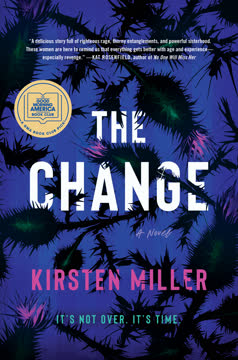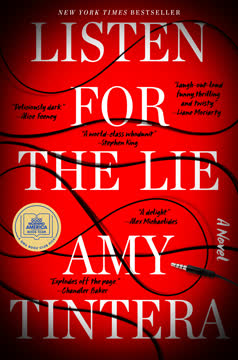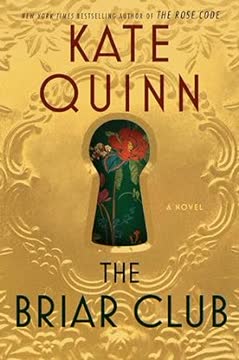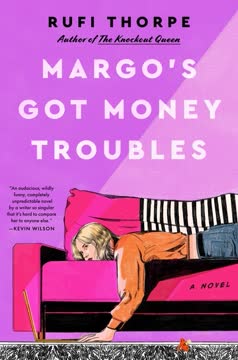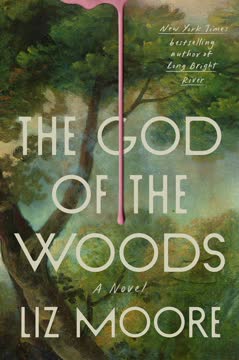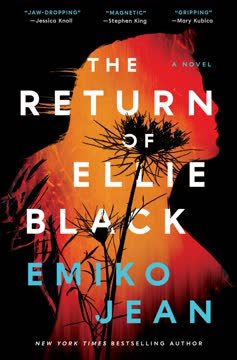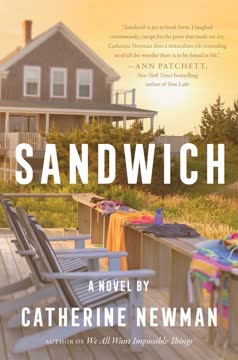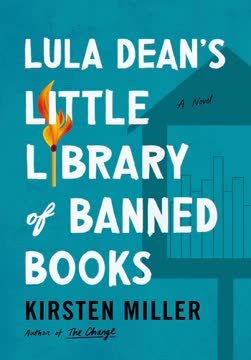Plot Summary
Gone to Seed
Harriett Osborne's once-pristine home and garden have become wild and overgrown, the talk of the Mattauk neighborhood. After her high-powered career and marriage collapse, Harriett withdraws from society, letting her property—and herself—go to seed. Neighbors speculate about her fate, but Harriett is not broken; she is changing. The neglect is not a sign of defeat but a rejection of the rules that have bound her. As the Homeowners Association circles, Harriett's refusal to conform signals the start of a personal revolution. Her transformation is both physical and metaphysical, as she discovers a new power within herself, one that will soon connect her to other women on the brink of their own awakenings.
Powers Awaken
Jo Levison, a former hotel manager turned gym owner, and Nessa James, a widowed nurse with a supernatural gift, are both experiencing profound changes. For Jo, menopause brings not decline but a surge of energy—literal heat and strength that she channels into her all-women's gym, Furious Fitness. Nessa, after years of silence, begins to hear the voices of the dead again, a family gift that skipped a generation and now returns with force. These changes, once feared, become sources of power. The three women—Harriett, Jo, and Nessa—are drawn together by their abilities and their shared sense that the world has underestimated them for too long.
The Quiet Life
Nessa's life, once filled with family and purpose, has grown silent after her daughters leave for college and her husband's death. The quiet is broken by the return of her ability to hear the dead, a gift passed down from her grandmother. The voices are not random—they are girls, lost and calling to be found. Nessa's memories of her grandmother's work in the South, finding bodies the police ignored, shape her response. She realizes her gift is not a curse but a calling, and she must act, even as the burden threatens to overwhelm her.
Three Women Unite
Harriett, Jo, and Nessa, each isolated by their circumstances and powers, are brought together by fate and necessity. Their meeting is catalyzed by the discovery of a dead girl near Danskammer Beach, a body that only Nessa could have found. Jo's physical power, Harriett's botanical magic, and Nessa's connection to the dead form a complementary alliance. They are united not just by supernatural gifts but by a shared rage at the injustices women face—ignored, dismissed, and endangered. Their friendship becomes the foundation for a campaign against the darkness lurking in their community.
The Girl in Blue
The trio's investigation begins with the body of a young Black girl, found wrapped in a trash bag near the beach. The police are quick to dismiss her as a sex worker who overdosed, but Nessa's visions and the evidence suggest otherwise. The girl's ghost lingers, unable to rest until her story is told. As the women dig deeper, they find connections to other missing girls, and the realization dawns that a predator is targeting the vulnerable. The discovery is not just about one victim but a pattern of violence and neglect that implicates the town's most powerful men.
Secrets in the Garden
Harriett's wild garden is more than a symbol of her rebellion—it is a living arsenal. She cultivates poisonous and medicinal plants, drawing on traditions of women's folk magic and healing. The garden becomes a sanctuary for the trio and a place where Harriett's powers grow. She uses her knowledge to heal, to punish, and to protect. The garden's transformation mirrors Harriett's own, as she sheds the expectations of wife, worker, and neighbor to become something new: a witch in the truest, oldest sense.
The Pointe's Dark Heart
The investigation leads the women to Culling Pointe, an exclusive enclave of the ultra-wealthy, hidden behind gates and manicured lawns. The Pointe is a world apart, ruled by men who believe themselves untouchable. Here, the trio uncovers a network of exploitation: girls lured for work or opportunity, then abused and discarded. The men of the Pointe, aided by complicit women and corrupt police, have created a system where their crimes are invisible. The women's powers are tested as they confront not just individuals but an entire structure built to protect predators.
The Missing and the Dead
As more girls' ghosts appear to Nessa, the scale of the crime becomes clear. The missing are not runaways or addicts, as the authorities claim, but daughters, sisters, and friends—many from marginalized backgrounds. The trio's efforts to identify the victims and bring their stories to light are met with resistance from the police and the community. The women realize that justice for the dead will require more than evidence; it will require breaking the silence and the systems that allow such violence to persist.
The Web of Men
The investigation reveals a web of complicity: police chief Rocca, billionaire Leonard Shaw, art dealer Spencer Harding, and others are all implicated in the trafficking and murder of girls. The law, meant to protect, instead shields the powerful. Attempts to go through official channels are thwarted by lies, cover-ups, and the rewriting of history. Even the media, when finally engaged, is manipulated or silenced. The women must decide whether to play by the rules or to take justice into their own hands.
The Witch's Justice
Harriett's powers reach their zenith as she turns her garden and her knowledge of poisons against those who have harmed women. She exacts poetic justice: invasive plants overrun the Pointe, bees attack the guilty, and mold consumes the corrupt. Her actions are not random but targeted, a form of retribution that the law cannot or will not deliver. Harriett embodies the archetype of the witch as avenger, using the tools of nature to balance the scales.
The Podcast Gamble
With official channels closed, the trio turns to a true crime podcast, They Walk Among Us, to tell the world what is happening in Mattauk. Their story, evidence, and the discovery of more bodies force the public to pay attention. The podcast becomes a double-edged sword: it brings attention and pressure, but also danger, as the powerful move to silence the women and those who help them. The battle for truth becomes a battle for survival.
The System Fails
Despite their efforts, the women see their work co-opted and erased. The police chief takes credit for their discoveries, the media spins a new narrative, and the true scale of the crimes is downplayed. The podcast host is murdered, and the women are left to realize that the system is designed to protect itself, not the vulnerable. The trio must confront the reality that justice, as defined by men, is not justice at all.
The Firestarter
Pushed to the brink by the system's failures and the continued threat to her daughter, Jo embraces her power fully. Her rage becomes literal fire, as she sets ablaze the invasive plants Harriett has seeded throughout the Pointe. The fire spreads, consuming the homes and secrets of the powerful. Jo's act is not just vengeance but a cleansing—a refusal to accept a world built on women's suffering. The fire is both an ending and a beginning.
Wolves Unmasked
As the fire burns, the final truths come to light. Claude, once an ally, is revealed as a facilitator of the abuse, rationalizing her actions as harm reduction. Leonard, the philanthropist, is unmasked as a monster. The women see that evil is not just individual but systemic, perpetuated by those who benefit from it and those who look away. The reckoning is not just for the men but for the women who enabled them.
The Reckoning
With the old order in ruins, the trio and their allies mete out their own justice. The guilty are punished—some by supernatural means, others by exposure and death. The women refuse to be erased or silenced. They claim their power, not just for themselves but for all the girls who were lost. The reckoning is not just retribution but a declaration: never again.
Burn It Down
The fire at Culling Pointe is both literal and symbolic. The mansions, symbols of wealth and impunity, are reduced to ash. The land is reclaimed for nature and for the community. The women's actions inspire others to speak out, to fight back, and to imagine a world where girls are safe and valued. The trio's powers, once sources of shame or fear, are now celebrated as tools of liberation.
The Others
The story ends not with the trio alone but with a movement. Jo's self-defense program for girls expands, funded by the fortunes of the fallen. Nessa continues to help the dead find peace, and Harriett's garden becomes a place of healing and power. The women's alliance inspires others to claim their own strength. The world is not yet safe, but it is changing. The old order is gone, and a new one—fierce, just, and female—is rising.
A New World Begins
In the aftermath, the women gather with their families and community, celebrating survival and the promise of a better future. The land once tainted by violence is now a sanctuary. The trio's legacy is not just vengeance but transformation—a world where women's power is recognized, where girls are taught to fight, and where the monsters no longer rule. The change is not just personal but collective, a revolution that has only just begun.
Characters
Harriett Osborne
Harriett is the catalyst of the story—a woman who, after losing her career and marriage, embraces the power that comes with age and anger. Her garden, wild and untamed, mirrors her own transformation from a controlled, "good" woman to a witch in the archetypal sense: healer, poisoner, and avenger. Harriett's relationship with Jo and Nessa is both maternal and sisterly; she guides, protects, and, when necessary, punishes. Psychologically, Harriett embodies the rage and wisdom of women who have been dismissed and diminished, channeling it into action. Her development is a journey from isolation and shame to unapologetic power, using her knowledge of nature to exact justice where the law fails.
Jo Levison
Jo is a former hotel manager who reinvents herself as the owner of an all-women's gym. Menopause, often seen as decline, becomes her source of superhuman strength and heat. Jo's journey is one of reclaiming her body and her anger, which she learns to wield as both shield and weapon. Her relationship with her husband and daughter grounds her, but her true growth comes from embracing her role as protector—not just of her family, but of all women. Jo's psychological arc is about moving from self-doubt and internalized shame to fierce self-acceptance and leadership. Her rage, once a liability, becomes the fire that burns down the old world.
Nessa James
Nessa is a widowed nurse whose supernatural ability to hear the dead returns as her life grows quiet. Her gift, inherited from her grandmother, is both a burden and a calling. Nessa's role is to bear witness, to ensure that the lost girls are not forgotten, and to help their families find peace. Her psychological journey is one of moving from grief and isolation to purpose and connection. Nessa's empathy and courage make her the moral center of the trio, and her willingness to see what others cannot is both her strength and her cross to bear.
Claude Marchand
Claude is a woman who, after losing everything in a financial scandal, reinvents herself as a fixer for the rich. She rationalizes her role in the exploitation of girls as harm reduction, but is ultimately complicit in the system's violence. Claude's relationship with Leonard and the other men of the Pointe is transactional; she trades her skills for security and influence. Psychologically, Claude is a study in self-deception and the dangers of complicity. Her eventual reckoning is both personal and symbolic—a warning about the cost of survival at the expense of others.
Leonard Shaw
Leonard is the billionaire philanthropist who presents himself as a force for good, funding schools and charities. Beneath the surface, he is a key architect of the Pointe's system of abuse. His relationship with Claude is both romantic and exploitative; he uses her to facilitate his crimes. Leonard's psychological profile is that of the charming sociopath, able to rationalize any action in the name of the greater good. His downfall is a reminder that evil often wears a friendly face.
Chief John Rocca
Rocca is the police chief who uses his position to enable and participate in the exploitation and murder of girls. He is the embodiment of institutional corruption, hiding behind the law while preying on the vulnerable. Rocca's psychological makeup is that of the abuser who believes himself untouchable, protected by his role and the silence of others. His eventual exposure and death are a form of poetic justice, but also a commentary on how many like him escape accountability.
Spencer Harding
Harding is the central antagonist, a wealthy art dealer who uses his power and connections to traffic and murder girls. He is protected by money, status, and a network of enablers. Harding's psychological profile is that of the narcissistic predator, seeing others as objects for his pleasure. His death is both a victory and a warning—the system that created him is still in place.
Faith Reid
Faith is the "girl in blue," whose murder sets the story in motion. Her ghost lingers, demanding justice and recognition. Faith's story is emblematic of the many girls whose disappearances are ignored or misrepresented. Her presence in the narrative is a constant reminder of the stakes and the cost of indifference.
Amber Welsh
Amber is the mother of Mandy Welsh, one of the missing girls. Her struggle to get the police and community to care about her daughter's disappearance highlights the intersection of class, gender, and power. Amber's pain and anger fuel the trio's determination, and her eventual escape is both a victory and a tragedy—she survives, but at great cost.
Franklin Rees
Franklin is the rare good man in the story, a detective who believes Nessa and helps the trio navigate the investigation. His relationship with Nessa is one of mutual respect and growing love. Franklin's psychological role is to show that men can be allies, but that true change requires women to lead. He is supportive, but never the savior.
Plot Devices
Menopause as Superpower
The novel uses menopause—a stage often stigmatized—as the trigger for the women's supernatural abilities. This device reframes aging as a source of strength, not weakness, and challenges cultural narratives about women's value. The powers are metaphors for the wisdom, rage, and freedom that come with age, and they drive the plot as the women move from victims to agents of change.
The Witch Archetype
Harriett's journey from outcast to witch is both literal and symbolic. The novel draws on traditions of folk magic, herbalism, and women's secret knowledge, using the witch as a figure of resistance and justice. The garden, poisons, and rituals are not just plot elements but symbols of women's power outside patriarchal structures.
Ghosts and the Unseen
Nessa's ability to see and hear the dead is a device that brings the hidden crimes to light. The ghosts are not just plot points but metaphors for the silenced and forgotten. Their presence forces the living to confront uncomfortable truths and to act where the system will not.
The Corrupt System
The novel uses the police, the media, and the wealthy enclave of Culling Pointe as embodiments of systemic evil. The plot is structured around the women's attempts to work within the system, their repeated betrayals, and their eventual decision to go outside the law. The failure of institutions is both a narrative engine and a thematic statement.
Fire and Nature
Jo's power to generate heat and fire, and Harriett's command of plants and animals, are used to literalize the idea of burning down the old world to make way for the new. The fire at the Pointe is both a climax and a cleansing, a device that allows for both vengeance and rebirth.
Foreshadowing and Parallelism
The novel uses stories from the past—Harriett's childhood, Nessa's grandmother, the history of the island—to foreshadow the present struggle. The repetition of patterns (girls going missing, women being dismissed) is paralleled by the emergence of new patterns (women uniting, powers awakening). The structure reinforces the idea that change is both necessary and possible.
Analysis
Kirsten Miller's The Change is a fierce, genre-bending feminist thriller that reimagines the "witch" not as a figure of fear, but as a necessary force for justice in a world built to protect predators and silence victims. By granting her protagonists supernatural powers at menopause, Miller subverts cultural narratives of decline, instead celebrating the wisdom, rage, and freedom that come with age. The novel is both a gripping mystery and a manifesto, exposing the ways in which institutions—police, media, the wealthy—collude to erase the suffering of women and girls, especially those who are poor or marginalized. Through the alliance of Harriett, Jo, and Nessa, Miller argues that true change comes not from working within a broken system, but from burning it down and building something new. The story is unflinching in its depiction of violence and complicity, but ultimately hopeful: it imagines a world where women claim their power, honor the lost, and refuse to be erased. The lesson is clear—rage, wisdom, and solidarity are not just survival tools, but the engines of revolution.
Last updated:
FAQ
Synopsis & Basic Details
What is The Change about?
- Women's Midlife Awakening: The Change by Kirsten Miller follows three women in the seemingly idyllic town of Mattauk, New York, who discover extraordinary powers as they navigate midlife. Harriett Osborne, a former advertising executive, cultivates a wild, potent garden; Jo Levison, a gym owner, experiences surges of physical strength and heat; and Nessa James, a widowed nurse, hears the voices of the dead.
- Unraveling a Dark Conspiracy: Their newfound abilities draw them into a chilling local mystery: the discovery of a murdered teenage girl's body, dismissed by corrupt authorities. This leads them to uncover a wider pattern of disappearances and deaths connected to the ultra-wealthy enclave of Culling Pointe, exposing a systemic network of exploitation and murder.
- Justice Beyond the Law: Frustrated by a legal system designed to protect the powerful, the trio unites to seek justice for the forgotten victims. They leverage their unique strengths—Harriett's botanical knowledge, Jo's fierce protective rage, and Nessa's spiritual connection—to dismantle the corrupt structures and bring down the men who believe themselves untouchable.
Why should I read The Change?
- Empowering Feminist Narrative: Readers seeking a powerful story of female empowerment will find The Change deeply resonant, as it redefines midlife for women as a period of awakening and strength, rather than decline. It champions female rage and solidarity as forces for profound societal change.
- Gripping Mystery with Depth: Beyond its thrilling plot, the novel offers a nuanced exploration of systemic corruption, class disparities, and the objectification of women, making it a thought-provoking read. The blend of supernatural elements with a realistic crime narrative creates a unique and compelling experience.
- Unforgettable Characters & Themes: The three protagonists are complex, relatable, and inspiring, each embodying different facets of female power and resilience. The Change delves into themes of justice, vengeance, community, and the reclamation of self, leaving a lasting impact on its audience.
What is the background of The Change?
- Suburban Façade & Hidden Darkness: The novel is set in Mattauk, a fictional coastal town in New York, which initially appears as a picturesque, affluent suburb. This setting provides a stark contrast to the dark underbelly of exploitation and murder that the protagonists uncover, highlighting how privilege can mask profound corruption.
- Reclaiming the "Witch" Archetype: Kirsten Miller draws on historical and cultural contexts where women with knowledge or power were often labeled as "witches" and persecuted. The book reclaims this archetype, presenting Harriett and her allies as figures of resistance and justice, tapping into ancient traditions of female wisdom and folk magic.
- Critique of Patriarchal Systems: The narrative is deeply rooted in a critique of patriarchal societal structures, particularly how they enable powerful men to commit crimes with impunity and how institutions like law enforcement and media can be complicit in covering up these injustices. The author's background in advertising also informs the critique of how women are perceived and marketed to.
What are the most memorable quotes in The Change?
- "For the first time in my life, I'm not bound by anything." (Harriett Osborne): This quote encapsulates Harriett's radical liberation from societal expectations and patriarchal control after her divorce. It marks her embrace of true freedom and the beginning of her transformation into an unapologetic force of nature, a core theme in The Change.
- "The Commandments only apply to humans. Nobody goes to hell for killing a monster." (Nessa's Grandmother): This powerful line, shared by Nessa's grandmother, provides a moral framework for the women's actions, justifying their extra-legal pursuit of justice against truly evil men. It highlights the novel's exploration of vengeance versus traditional justice.
- "Rage, wisdom, and solidarity are not just survival tools, but the engines of revolution." (Narrator/Analysis): While from the existing analysis, this quote perfectly distills the core message and driving force behind the women's collective journey. It emphasizes the transformative power of shared female experience and collective action in The Change.
What writing style, narrative choices, and literary techniques does Kirsten Miller use?
- Visceral and Evocative Prose: Miller employs a direct, often visceral writing style that plunges the reader into the characters' emotional and physical experiences. Descriptions of Jo's internal heat or Nessa's sensory overload from the dead are intensely rendered, making the supernatural elements feel grounded and immediate.
- Multiple Third-Person Perspectives: The narrative shifts between the close third-person perspectives of Harriett, Jo, and Nessa, allowing for deep dives into their individual psychologies and motivations. This choice builds empathy and provides a multifaceted view of the unfolding events, enriching the character motivations analysis.
- Symbolism and Intertextual Allusion: The novel is rich with symbolism, from Harriett's wild garden representing untamed female power to the recurring motif of fire as cleansing rage. Miller also weaves in intertextual allusions, such as Jo's connection to Carrie and Faith's subversion of the Garden of Eden myth, adding layers of meaning and inviting deeper symbolism analysis.
Hidden Details & Subtle Connections
What are some minor details that add significant meaning?
- Jeremy Aversano's Mushroom Discovery: The initial discovery of the "fleshy, faintly gray" mushroom by Jeremy Aversano's dog (Chapter 1, "Gone to Seed") is a subtle, early hint of Harriett's burgeoning botanical powers. It foreshadows her ability to manipulate nature for her own ends, linking her seemingly benign gardening to later acts of Harriett Osborne's vengeance.
- Rosamund's Apple Carving: Rosamund Harding carving "FAITH" into an apple and tossing it to Jo and Harriett (Chapter 10, "On Top of the World") is a desperate, ingenious act of communication. This seemingly small detail is crucial for unlocking the locker and revealing the photographic evidence, highlighting Rosamund's subtle rebellion and the women's intuitive understanding.
- The "Bad Seed" Nickname: Harriett's childhood nickname, "the Bad Seed" (Chapter 16, "Burn It Down"), is a poignant callback to her early trauma and the societal judgment she faced for her innate power. It reveals a deep-seated wound that informs her later embrace of her "witch" identity and her willingness to exact justice outside the law.
What are some subtle foreshadowing and callbacks?
- Brendon Baker's Plant Infestation: The rapid, aggressive growth of "hogweed," "nightshade," and "jimson weed" in Brendon Baker's yard (Chapter 2, "Hot and Bothered") subtly foreshadows Harriett's later, more deliberate use of invasive species and poisons against her enemies. It establishes her connection to nature's destructive power, a key aspect of Harriett Osborne's motivations.
- Jo's "Carrie" Connection: Jo's childhood memory of being called "Carrie" and her later realization that she "should have read the rest of Carrie" (Chapter 4, "Josephine Levison's Thirty-Year War") is a powerful callback. It foreshadows her own explosive, fiery rage and her eventual embrace of destructive power, linking her personal history to the broader themes in The Change of female retribution.
- The Whale's Consistent Presence: The recurring appearance of the female humpback whale near Culling Pointe, seemingly "escorting" the women or "covering for them" (Chapter 8, "Hurling Begonias," and Chapter 17, "Whales"), subtly suggests a deeper, almost mystical alliance between nature and the protagonists. It hints at Harriett's unique connection to the natural world and the idea that the universe itself is aligning with their cause.
What are some unexpected character connections?
- Juliet Rocca's Secret Alliance: The revelation that Juliet Rocca, the police chief's wife, secretly sought Harriett's help for her bulimia and later provided crucial information about Mei Jones (Chapter 20, "Juliet Rocca's Last Dish," and Epilogue) is an unexpected connection. It highlights the pervasive reach of patriarchal harm, even into seemingly privileged homes, and shows how women from different social strata can find solidarity in their suffering.
- Claude Marchand's Personal History: Claude's backstory, revealing her father's Ponzi scheme and her own near-victimization (Chapter 13, "Claude Marchand Plays Her Hand"), creates an unexpected parallel with the girls she later helps exploit. This complex history explains her initial complicity and her eventual, violent turn against Leonard, adding layers to her Claude Marchand character analysis.
- Franklin Rees's Childhood Encounter: Franklin's confession of his childhood encounter with a woman who "saw dead people" (Chapter 9, "Picket Fences") is an unexpected connection to Nessa's gift. It establishes his inherent openness to the supernatural and explains his willingness to believe Nessa, solidifying his role as a crucial male ally in The Change.
Who are the most significant supporting characters?
- Franklin Rees: The Trustworthy Ally: Franklin Rees, the detective, is pivotal as the only male authority figure who genuinely believes and supports Nessa. His personal history of encountering the "unseen" and his unwavering commitment to justice, even at the cost of his career, makes him indispensable. He represents the possibility of male allyship within a corrupt system, a key element in The Change's themes.
- Claude Marchand: The Complicit Survivor: Claude Marchand, Leonard Shaw's girlfriend and party planner, is significant for her complex role as both a victim of patriarchal systems and an enabler of the abuse at Culling Pointe. Her journey from rationalizing complicity to violently seeking personal vengeance against Leonard highlights the moral ambiguities and difficult choices women face in such environments, deepening the Claude Marchand motivations.
- Amber Welsh: The Marginalized Voice: Amber Welsh, Mandy's mother, is crucial for representing the marginalized victims and their families whose pleas are ignored by the authorities. Her initial despair and eventual, albeit costly, escape underscore the systemic indifference to the poor. Her story fuels the trio's resolve and emphasizes the class dimensions of the crimes in The Change.
Psychological, Emotional, & Relational Analysis
What are some unspoken motivations of the characters?
- Harriett's Desire for Control: Beneath Harriett's calm exterior and philosophical musings lies a deep-seated motivation to reclaim control, stemming from a lifetime of being underestimated and her mother's violent death. Her meticulous gardening and strategic vengeance are not just about justice, but about asserting absolute dominion over her environment and her fate, a core aspect of Harriett Osborne's motivations.
- Jo's Need for Validation: Jo's relentless drive, even before her powers manifest, is subtly fueled by a need for validation in a world that constantly dismisses women's professional capabilities. Her fury at Jeremy Aversano's condescension and her subsequent decision to liquidate her 401(k) (Chapter 12, "Jo Sets a Bridge Ablaze") reveal a deep-seated desire to prove her worth and protect her daughter from similar systemic invalidation.
- Nessa's Guilt and Redemption: Nessa's intense dedication to finding the dead girls is driven by an unspoken guilt over her inability to save her husband, Jonathan, and her initial withdrawal from her gift. Her relentless pursuit of justice for the forgotten girls is a path to personal redemption, transforming her grief into a powerful, empathetic force, central to Nessa James's emotional arc.
What psychological complexities do the characters exhibit?
- Harriett's Calculated Detachment: Harriett exhibits a complex psychological shift from a woman seeking external validation to one operating with a chilling, almost amoral detachment in her pursuit of vengeance. Her ability to calmly discuss poisoning while sipping champagne (Chapter 17, "Whales") reflects a mind that has transcended conventional morality, seeing her actions as a natural balancing of scales, a key aspect of Harriett Osborne's psychological analysis.
- Jo's Internalized Rage and Externalized Power: Jo's psychological complexity lies in her struggle to reconcile her internalized societal expectations (e.g., "don't burn bridges") with the explosive, literal power of her rage. Her initial fear of her own strength gives way to a fierce, protective instinct, but the internal battle to wield this power responsibly, as seen in her hesitation to "kill him" (Chapter 15, "Going Rogue"), highlights her ongoing moral compass.
- Claude's Self-Deception and Rationalization: Claude's character is a study in psychological self-deception, as she rationalizes her complicity in the exploitation of girls as "harm reduction" and philanthropy (Chapter 21, "Burn It Down"). Her belief that she is "making sure some good came out of it all" reveals a complex coping mechanism to justify her actions and maintain her self-image, a critical element in Claude Marchand's character analysis.
What are the major emotional turning points?
- Harriett's Divorce Epiphany: Harriett's emotional turning point occurs when her husband leaves her, and she realizes that "for the first time in my life, I was alone. And for the first time in my life, I knew what the hell I was doing" (Chapter 5, "The Purification of Harriett Osborne"). This moment of profound clarity, born from betrayal, liberates her from societal constraints and allows her to embrace her true power, a pivotal moment in Harriett Osborne's transformation.
- Jo's Hotel Assault and Grand Central Breakdown: Jo's emotional breaking point is the hotel assault incident, culminating in her physical outburst and subsequent breakdown at Grand Central Terminal (Chapter 4, "Josephine Levison's Thirty-Year War"). This experience shatters her illusions about the system and her own body, transforming her internalized shame into a burning, externalized rage that fuels her future actions and her Jo Levison motivations.
- Nessa's Eulogy for Mandy Welsh: Nessa's eulogy at Mandy Welsh's funeral (Chapter 19, "Mayday") marks a significant emotional turning point. Overcoming her fear and grief, she publicly speaks truth to power, giving voice to the marginalized and forgotten. This act solidifies her role as the "light that holds back the darkness" (Chapter 8, "Hurling Begonias") and empowers her to fully embrace her gift, a key moment in Nessa James's emotional arc.
How do relationship dynamics evolve?
- Jo and Art: From Resentment to Rebar: Jo and Art's relationship evolves from one strained by Jo's sole breadwinning and Art's perceived idleness to a renewed partnership. Art's unwavering support after the break-in, telling Jo, "You may be the concrete, but I'm the rebar" (Chapter 16, "Where Do All the Girls Go?"), signifies a shift from traditional gender roles to a mutually supportive, albeit unconventional, alliance, exploring relationship dynamics in The Change.
- Nessa and Franklin: From Professional to Intimate Alliance: The dynamic between Nessa and Franklin transforms from a professional detective-witness relationship to a deep, trusting, and eventually romantic bond. Franklin's belief in Nessa's "gift" and his willingness to risk his career for her (Chapter 10, "Faith") solidifies their connection, demonstrating how shared purpose and vulnerability can forge powerful personal relationships.
- Harriett and Celeste: Unconventional Empowerment: Harriett and Celeste's relationship evolves from a secret affair to an open, empowering alliance. Celeste's internal monologue about Harriett teaching her to "see the world with her own two eyes" (Chapter 8, "Hurling Begonias") highlights how Harriett's unapologetic self-acceptance inspires Celeste's own liberation from societal expectations and a stifling marriage, showcasing unique character connections in The Change.
Interpretation & Debate
Which parts of the story remain ambiguous or open-ended?
- The Full Extent of the "Change": The exact nature and limits of the women's powers, particularly Harriett's, remain somewhat ambiguous. While Jo's heat and Nessa's visions are clearer, Harriett's ability to "summon" plants, control animals, and even cause death (e.g., Jackson Dunn's bees, John Willis's seagulls) borders on the truly supernatural, leaving readers to debate whether it's metaphor or literal magic. This ambiguity enhances the symbolism in The Change.
- The Future of the "New World": The epilogue, while hopeful, leaves the long-term success and sustainability of the women's revolution open-ended. While Culling Pointe is destroyed and the self-defense program expands, the systemic nature of the "wolves" suggests an ongoing battle. Readers are left to ponder whether this "new world" can truly endure or if it's a temporary victory in a perpetual war, a key theme in The Change.
- The Unidentified Victims: Despite Nessa's efforts and Franklin's dedication, the third girl found in the lobster traps (Mei Jones) and other potential victims from Franklin's files remain largely unidentified or without families to claim them. This ambiguity underscores the lasting impact of systemic neglect
Synopsis & Basic Details
What is The Change about?
- Women's Midlife Awakening: The Change by Kirsten Miller follows three women in the seemingly idyllic town of Mattauk, New York, who discover extraordinary powers as they navigate midlife. Harriett Osborne, a former advertising executive, cultivates a wild, potent garden; Jo Levison, a gym owner, experiences surges of physical strength and heat; and Nessa James, a widowed nurse, hears the voices of the dead.
- Unraveling a Dark Conspiracy: Their newfound abilities draw them into a chilling local mystery: the discovery of a murdered teenage girl's body, dismissed by corrupt authorities. This leads them to uncover a wider pattern of disappearances and deaths connected to the ultra-wealthy enclave of Culling Pointe, exposing a systemic network of exploitation and murder.
- Justice Beyond the Law: Frustrated by a legal system designed to protect the powerful, the trio unites to seek justice for the forgotten victims. They leverage their unique strengths—Harriett's botanical knowledge, Jo's fierce protective rage, and Nessa's spiritual connection—to dismantle the corrupt structures and bring down the men who believe themselves untouchable.
Why should I read The Change?
- Empowering Feminist Narrative: Readers seeking a powerful story of female empowerment will find The Change deeply resonant, as it redefines midlife for women as a period of awakening and strength, rather than decline. It champions female rage and solidarity as forces for profound societal change.
- Gripping Mystery with Depth: Beyond its thrilling plot, the novel offers a nuanced exploration of systemic corruption, class disparities, and the objectification of women, making it a thought-provoking read. The blend of supernatural elements with a realistic crime narrative creates a unique and compelling experience.
- Unforgettable Characters & Themes: The three protagonists are complex, relatable, and inspiring, each embodying different facets of female power and resilience. The Change delves into themes of justice, vengeance, community, and the reclamation of self, leaving a lasting impact on its audience.
What is the background of The Change?
- Suburban Façade & Hidden Darkness: The novel is set in Mattauk, a fictional coastal town in New York, which initially appears as a picturesque, affluent suburb. This setting provides a stark contrast to the dark underbelly of exploitation and murder that the protagonists uncover, highlighting how privilege can mask profound corruption.
- Reclaiming the "Witch" Archetype: Kirsten Miller draws on historical and cultural contexts where women with knowledge or power were often labeled as "witches" and persecuted. The book reclaims this archetype, presenting Harriett and her allies as figures of resistance and justice, tapping into ancient traditions of female wisdom and folk magic.
- Critique of Patriarchal Systems: The narrative is deeply rooted in a critique of patriarchal societal structures, particularly how they enable powerful men to commit crimes with impunity and how institutions like law enforcement and media can be complicit in covering up these injustices. The author's background in advertising also informs the critique of how women are perceived and marketed to.
What are the most memorable quotes in The Change?
- "For the first time in my life, I'm not bound by anything." (Harriett Osborne): This quote encapsulates Harriett's radical liberation from societal expectations and patriarchal control after her divorce. It marks her embrace of true freedom and the beginning of her transformation into an unapologetic force of nature, a core theme in The Change.
- "The Commandments only apply to humans. Nobody goes to hell for killing a monster." (Nessa's Grandmother): This powerful line, shared by Nessa's grandmother, provides a moral framework for the women's actions, justifying their extra-legal pursuit of justice against truly evil men. It highlights the novel's exploration of vengeance versus traditional justice.
- "Rage, wisdom, and solidarity are not just survival tools, but the engines of revolution." (Narrator/Analysis): While from the existing analysis, this quote perfectly distills the core message and driving force behind the women's collective journey. It emphasizes the transformative power of shared female experience and collective action in The Change.
What writing style, narrative choices, and literary techniques does Kirsten Miller use?
- Visceral and Evocative Prose: Miller employs a direct, often visceral writing style that plunges the reader into the characters' emotional and physical experiences. Descriptions of Jo's internal heat or Nessa's sensory overload from the dead are intensely rendered, making the supernatural elements feel grounded and immediate.
- Multiple Third-Person Perspectives: The narrative shifts between the close third-person perspectives of Harriett, [Jo](#jo-lev
Review Summary
The Change is a feminist revenge fantasy that combines elements of mystery, magical realism, and social commentary. Three menopausal women develop supernatural powers and use them to investigate murders of young girls in their Long Island community. While praised for its empowering themes, unique characters, and witty writing, some readers found it too long and heavy-handed in its portrayal of men. The book polarized readers, with many loving its fierce female protagonists and others finding it overdone. Despite mixed reactions, it garnered significant attention and sparked discussions about gender inequality.
Similar Books
Download PDF
Download EPUB
.epub digital book format is ideal for reading ebooks on phones, tablets, and e-readers.
